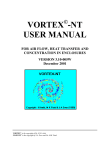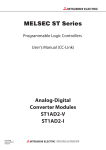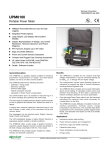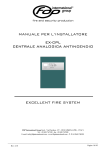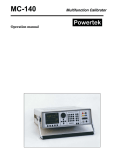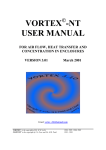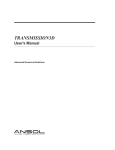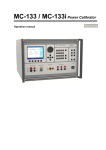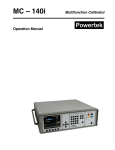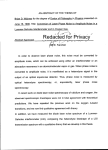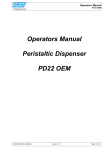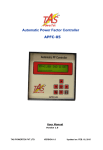Download MC151 User Manual pdf
Transcript
Powertek
MC151 Current calibrator
Content
1
Basic information ....................................................................................................................... 5
2
Preparation for operation .......................................................................................................... 6
3
4
5
2.1
Inspecting package contents, selecting the installation location .................................... 6
2.2
Power-on.............................................................................................................................. 6
2.3
Warm-up time .................................................................................................................... 7
2.4
Replacement of fuse ........................................................................................................... 7
2.5
Safety precautions .............................................................................................................. 7
Description of controls ............................................................................................................... 8
3.1
Front panel .......................................................................................................................... 8
3.2
Rear panel ......................................................................................................................... 12
Control of the calibrator .......................................................................................................... 13
4.1
Selection of function ......................................................................................................... 13
4.2
Setting the value of output signal .................................................................................... 14
4.3
Connection / disconnection of output terminals ............................................................ 15
4.4
SOURCE mode ................................................................................................................. 15
4.5
AMPLIFIER mode ........................................................................................................... 17
Multimeter ................................................................................................................................ 18
5.1
6
7
Function selection ............................................................................................................. 18
Calibrator setup menu (Main menu)....................................................................................... 19
6.1
General Menu ................................................................................................................... 19
6.2
Interface Menu ................................................................................................................. 20
6.3
Calibrator Menu ............................................................................................................... 20
6.4
Meter Menu ...................................................................................................................... 21
6.5
Calibration Menu ............................................................................................................. 22
Calibration mode ...................................................................................................................... 23
7.1
Calibration principles ...................................................................................................... 23
7.2
Access to the calibration procedure ................................................................................ 23
7.3
Selection of calibration type ............................................................................................ 24
7.4
Full calibration procedure ............................................................................................... 27
8
Error messages ......................................................................................................................... 30
9
Maintenance ............................................................................................................................. 31
3
Version 10
Operation manual
MC151 Current calibrator
Powertek
10
Verification test .....................................................................................................................33
11
System control .......................................................................................................................37
11.1
IEEE488 bus properties ................................................................................................37
11.2
RS232 serial line setting ................................................................................................37
11.3
Command syntax ...........................................................................................................38
11.4
Standard Status Data Structures .................................................................................53
12
Specification ..........................................................................................................................57
13
Accessories ............................................................................................................................59
Operation manual
4
MC151 Current calibrator
1
Powertek
Basic information
MC151 Current calibrator is accurate current source up to 120 A. It can be used for calibration of
ammeters or as stable current source for precise measurement. The calibrator is equipped with
a built-in multimeter that can be used for simulation of programmable transconductance or current
amplifier.
Basic features of the calibrator include generation of calibrated AC and DC current in the range of
8 mA to 120 A. Frequency range is 15 Hz to 1000 Hz.
Internal multimeter with ranges 200 mA, 20 V and 10 kHz can be used for simulation of
programmable transconductance or current amplifier.
The calibrator includes many other features which facilitate easy use. For example it is currently
displayed uncertainty of the output signal, calibration and testing procedures etc. The concept
of calibrator control and indication of its status is based on large TFT color display, which
provides all necessary information. The calibrator is controlled by opening menus on the display
and selection from menus. Frequently used functions are assigned direct-control keys. The
calibrator comes with standard IEEE488 bus and RS-232 serial line, which allow the calibrator to
be controlled from a PC.
The calibrator is supported in the automated calibration system Caliber.
5
Operation manual
MC151 Current calibrator
2
Powertek
Preparation for operation
2.1 Inspecting package contents, selecting the installation location
Basic package includes the following items:
MC151
•
•
•
•
•
•
Current calibrator
Power cord
Spare fuse
Operational manual
Test report
RS232 cable
The calibrator should be powered by 230/115 V – 50/60 Hz mains. It is a laboratory instrument
whose parameters are guaranteed at 23±3 oC. Before powering on the instruments, place it on a
level surface. Do not cover the vents at the front side and the fan opening at the rear panel.
2.2 Power-on
• Before connecting the calibrator to the mains, check the position of the mains voltage selector
located at the rear panel.
•
Plug one end of the power cord into the connector located at the rear panel and connect the
other end of the power cord into a wall outlet.
•
Switch on the mains switch located at the rear panel. Flat display is lit.
•
The calibrator performs internal hardware checks for 5 seconds.
•
After the tests conclude, the calibrator resets to its reference state, i.e. the following
parameters are set:
Function
AC current
Current range
1A
Set value
1A
Frequency
50 Hz
Output terminals
OFF
GPIB address of the calibrator is factory-preset to 2. This value is valid until the user changes
it.
Note. The calibrator resets to its reference status in case of power switching off and reconnection.
Operation manual
6
MC151 Current calibrator
Powertek
2.3 Warm-up time
The calibrator works after it is switched on and the initial checks complete. Specified parameters
are only guaranteed after the instrument warms up for 60 minutes. During this period, the
instrument cannot be calibrated.
2.4 Replacement of fuse
The calibrator includes a fuse located next to the mains connector at the rear panel. Replace the
fuse as follows:
•
Switch off the calibrator
•
Remove the end of power cord from the mains connector at the rear panel.
•
Insert the blade of a flat screwdriver into the opening cut in the mains voltage selector and pull
out the fuse holder.
•
Remove the fuse and replace it with new fuse of the same rating.
2.5 Safety precautions
The instrument has been designed in Safety Class I according to EN 61010-1. The design reflects
the requirements of A2 amendment of the standard.
Safety is ensured by the design and by the use of specific component types.
The manufacturer is not liable for the damage caused by modification of the construction or
replacement of parts with non-original ones.
Safety symbols used on the equipment
Warning, reference to the documentation
Warning - risk of electric shock
7
Operation manual
MC151 Current calibrator
3
Powertek
Description of controls
3.1
Front panel
The front panel of the calibrator includes a TFT color display, control keys and output terminals.
The following picture shows the control part of the front panel.
9
1
2
3
4
5
8
6
6
7
1
Cursor keys
Using these keys, the cursor can be controlled within allowed limits on the display. The keyboard
includes two keys (<, >) which allow the cursor to be set to the required position at the display.
The cursor can be moved to the left or right. These keys are usually used to step through the
options and to move from one option to another or between the menu levels. Numeric values can
be set in some control modes as well. In these cases, the keys marked (∧, ∨) allow the user to
increase or decrease the number at the cursor key.
The central key is used to select value you want to change (TAB).
2
Rotary knob
The rotary knob integrates several functions. By turning the knob to the left or right, the user can:
•
step through the options
•
enter numeric values
Operation manual
8
MC151 Current calibrator
Powertek
The function of the rotary knob can usually be performed by the cursor keys. The central key is
used to confirm the selection (Select) or change the function of the rotary knob (value change or
position change).
3
Numeric keyboard
The keyboard allows the entry of numeric values on the display. ENTER key is used to confirm
the selection. CANCEL key can be used to cancel the entry.
4
Function keys
Function keys can be used to call-up the functions of the calibrator directly. The following keys
are provided:
function
key
Source mode
Amplifier mode
Voltage measurement
Current measurement
Output Operate/Standby
SOURCE
AMPLIFIER
VOLTAGE
CURRENT
OPER
After the function mode is changed, the parameters of the respective function are restored. If the
respective function was never used, the calibrator resets to its reference values.
5
Power switch
Turns instrument AC power ON and OFF.
6
Air intake
A cold air intake is used to bring relatively cool air into a calibrator.
7
Current output
Current outputs HI and LO terminals.
8
Display keys
There are five keys below the display, whose meaning changes depending on the contents of the
display. These keys usually call-up the “local Menu” (units, modes, etc.).
9
Display
9
Operation manual
MC151 Current calibrator
A
Powertek
B3
B1
B4
B2
B5
C
D
The display is divided to three horizontal sections:
A. Upper information line
•
•
•
Selected function (Source AC)
Date and time
Remote control state (Local – keyboard, Remote – computer)
B. Main area
This section displays the set-up values of generated signals and the data related to the
calibrator status. The section includes the following types of data:
1. Main value
There is displayed main output value with the unit and indication of AC or DC (picture).
There is displayed also actual position of cursor ▼▲ if the parameter is in edit mode.
Position of cursor can be changed using keys <, > and parameter can be changed using
keys ∧, ∨, or using the rotary knob.
2. Auxiliary parameters
This section displays auxiliary parameters of actually selected function:
•
•
•
Frequency (AC functions)
Gain (Amplifier mode)
Step (Amplifier mode)
3. Outputs state
Window displays whether output terminals are connected or not connected.
Symbols displayed in window:
- output terminals are not connected, output is off
- output terminals are connected, output is on
4. Specification
In the field specification of set-up output signal is shown. Uncertainty is related to the
main parameter. Label BUSY instead of accuracy is displayed, if calibrator is not within
specified parameters or if internal reconnection is in process. This can occur during
changing the functions, changing set parameters, switching output terminals ON and OFF.
Operation manual
10
MC151 Current calibrator
Powertek
5. Information section
The information section located in the right part of the display and displays additional
information related to the selected function:
•
•
•
Information about the grounding method of output terminals: Gnd as set up using the
menu „Calibrator“.
Information about the use of turn coil as set up using the menu „Calibrator“.
Information about sync mode (only AC output).
C. Meter’s information section
D. Display softkeys
The functions of these keys change during operation (depends on actual display mode).
Colors on display
Common rules are used for applied color of labels and values.
1. Red color is applied, when displayed value is measured by the calibrator.
2. Blue color is applied for parameters or values, which can be set-up or modified directly
from front panel keyboard or via Main menu.
3. Black color is used for fix values, labels, notes, parameters which cannot be modified and
for other fix text with general information purpose.
4. Meaning of display keys is always shown the lowest line. If there is no description above
display key, the key is not active in selected function.
11
Operation manual
MC151 Current calibrator
3.2
Powertek
Rear panel
Rear panel includes meter input terminals, ventilation holes, power cord socket, power line fuse,
power line voltage selector 115/230V, fuse for internal multimeter, interface connectors GPIB and
RS232 and metal central ground terminal.
1
2
7
1
2
3
4
5
6
7
8
3
4
5
6
8
7
power line entry
power line fuse
power line switch
fuse for internal multimeter (F315mA / 250V)
central ground terminal
GPIB and RS-232
forced ventilation holes
meter input terminals
Operation manual
12
MC151 Current calibrator
4
Powertek
Control of the calibrator
4.1
Selection of function
After the power is switched on and the initial checks complete, the calibrator resets to its reference
state:
Function:
Current:
Frequency:
Source AC
1A
50Hz
The state of the calibrator can be changed using the keys located at the front panel in one of the
following ways:
1.
Change of function by pressing one of direct function keys
After pressing one of the keys SOURCE, AMPLIFIER, VOLTAGE or CURRENT calibrator
switches to the selected function and set the last set-up parameters. Whenever function is changed,
calibrator always goes over to STANBY position. Output terminals are disconnected.
2.
Connection /disconnection of output terminals
After pressing the OPER key, the output terminals of the calibrator are connected. To disconnect
active terminals push the OPER key again.
3.
Select AC /DC current
After pressing AC/DC softkey the calibrator changes AC to DC signal or DC to AC signal.
4.
Access to the Main menu
After pressing the SETUP softkey the calibrator displays the basic level of the setup menu. In this
menu you can change instruments setting and calibration data. Previous function is recalled after
pressing Exit softkey.
13
Operation manual
MC151 Current calibrator
4.2
Powertek
Setting the value of output signal
Edit mode
Parameters of output signal can be changed in Edit mode. Only parameters displayed in blue color
can be changed. Display can be switched to edit mode in different ways:
-
Pressing numeric key
Pressing „Select“ key (in the middle of cursors keys)
Pressing cursor key
Pressing the rotary knob
In edit mode is edited value highlighted by blue background. Pressing the „Select“ key you can
change among „blue“ parameters. Edit mode is finished by pressing „Exit“ softkey.
Entry of the value using numeric keyboard
•
Use the numeric keyboard to select the desired value. After the first digit is entered,
input box is displayed. In the upper row of the input box is the name of edited
parameter. Using softkeys you can enter the new value in different units.
•
Enter desired value.
•
After the entry is complete press softkey with requested unit or press „Enter“ key.
„Enter“ key inputs the value in basic units (A, Hz …).
•
Calibrator sets new value.
•
The value is copied to the appropriate field in the screen and the input box disappears.
Entry of the value using cursor keys
•
Press <, >, ∧ or ∨ key. The display now includes cursor marks which points to the
active digit.
•
∧ and ∨ keys can be used to change the active digit. <, > keys can be used to change
the position of the cursor marks
Operation manual
14
MC151 Current calibrator
•
Powertek
To get to the default screen, press „Exit“ key. All values can be set using the keys or
the rotary knob.
Entry of the value using the rotary knob
•
Press the rotary knob. The display now includes cursor marks which points to the
active digit.
•
Turn the knob to change the active digit
•
Press the rotary knob to change to the mode which allows changing the value of the
active digit. ← and → symbols are displayed above the active digit. Active digit can be
changed by turning the knob.
•
Turn the knob to change the position of the active digit.
•
To get to the default screen press „Exit“ key. All values can be set using the keys or the
rotary knob.
•
All parameters have limits (high and low). If the entered value is outside these limits
error message is displayed („Value too large (small)“) and new value is not accepted.
Note:
4.3
Connection / disconnection of output terminals
After switching the AC power supply on the output terminals are disconnected in all modes.
Press the “OPER” key to connect the output signal to the terminals. Symbol displayed in window:
Press the “OPER” key again to disconnect the output terminals. Symbol displayed in window
now:
Output terminals are disconnected automatically under following conditions:
4.4
15
•
Function mode change
•
Calibrator is overloaded.
•
Synchronization is lost (AMPLIFIER)
SOURCE mode
Operation manual
MC151 Current calibrator
Powertek
The calibrator can generate calibrated current. Output terminals for current ranges are CURRENT
OUTPUT HI – LO terminals.
Current setting range:
8 mA to 120 A
When 25-turn coil (option 151-25) is used, Current range is up to 3000 A.
Control in the SOURCE mode
•
Press “SOURCE” key on the calibrator and then select AC or DC mode by pressing display
key. The display shows the following data:
* main current through the CURRENT OUTPUT HI-LO terminals
* frequency, if AC current is selected
* uncertainty of current
•
Set desired value of current using numeric keyboard, rotary knob or cursor keys. Output
current is not yet connected to the output terminals.
•
Connect the instrument to be calibrated to CURRENT OUTPUT HI-LO.
•
Press OPER key.
•
Green symbol is lit on the display to indicate the connection of output terminals.
•
If Coil x25 or Coil user function is activated (see below – Main menu), the optional current
coil must be connected to the output terminals. The calibrator can be used to calibrate clamp
Amp meters up to 3000 A.
Overloading of output terminals
When external circuit connected to current output terminals is disconnected or there is higher
voltage at the load than permitted, the calibrator disconnects the output terminals and displays
„Output Overload“ message. The same message can be displayed when current coil is used for AC
current output at frequencies above 80 Hz. It depends on the set current and the type of ammeter
connected.
Setting the current in modes Idc Basic and Iac Basic
The calibrator allows several ways of setting the value of generated current.
1.
2.
Setting the current
•
Repeatedly press the “Select” key (in the middle of cursor keys) until the current value
appears in edit mode (grey background).
•
The value can be set using numeric keyboard and confirmed by pressing mA or A
softkey. The value can be set using cursor keys or rotary knob as well.
Setting the frequency (AC current only)
Operation manual
16
MC151 Current calibrator
4.5
Powertek
•
Repeatedly press the “Select” key (in the middle of cursor keys) until the frequency
value appears in edit mode (grey background).
•
The value can be set using numeric keyboard and confirmed by pressing Hz softkey.
The value can be set using cursor keys or rotary knob as well.
AMPLIFIER mode
The calibrator generates output current according to the input value measured by internal meter.
Current range: 8 mA to 120 A
When 25-turn coil (option 151-25) is used, Current range is up to 3000 A.
Control in the AMPLIFIER mode
•
Press “AMPLIFIER” key on the calibrator and then select AC or DC mode by pressing display
key. The display shows the following data:
*
*
*
*
*
main current through the CURRENT OUTPUT HI-LO terminals
uncertainty of current
frequency, if AC current is selected
gain of simulated amplifier
step of generated current (step 1.0 A means that output current is generated in entire
amperes – 1A, 2A, …, 120A)
•
Select type of he input signal by pressing VOLTAGE or CURRENT meter key.
•
Set required Gain and Step of the output current.
•
Connect the control signal (voltage or current) to the meter terminals located on the rear panel.
•
In case of internal frequency synchronization must be set also frequency of output current.
•
In case of external or power supply frequency synchronization, wait until the frequency is
synchronized (light green circle near the frequency value ).
•
Connect the instrument to be calibrated to CURRENT OUTPUT HI-LO.
•
Press OPER key.
•
Green symbol is lit on the display to indicate the connection of output terminals.
•
If Coil x25 or Coil user function is activated (see below – Main menu), the optional current
coil must be connected to the output terminals. The calibrator can be used to calibrate clamp
Amp meters up to 3000 A.
17
Operation manual
MC151 Current calibrator
5
Powertek
Multimeter
The calibrator includes a built-in multimeter which can measure AC/DC voltage, AC/DC current
and frequency. Measured signal must be connected to the terminals on the back side. Terminals
mA, COM are for current measurements. Terminals V, COM are for voltage and frequency
measurements.
5.1
Function selection
•
Measurement function should be selected in Main menu (item Meter) or
VOLTAGE/CURRENT keys.
•
Press UP, DOWN display keys or use the rotary knob to select one of the following functions:
* Voltage – AC voltage range 20 V/ 15 - 10000 Hz, DC voltage range 20 V
* Current – AC current range 200 mA / 15 - 10000 Hz , DC current range 200mA
Operation manual
18
MC151 Current calibrator
6
Powertek
Calibrator setup menu (Main menu)
The calibrator allows many other, less frequently used parameters to be set. Setup menu is used to
set these parameters. Setup menu is opened by pressing SETUP softkey. If output terminals are
connected, they will be disconnected and the following display appears:
Use ∧ or ∨ cursor key or the rotary knob to browse the menu options. Press „Select“ softkey or
press in on the rotary knob to select highlighted item. Press „Exit“ softkey to leave the selected
menu level.
New settings are retained when the calibrator is switched off.
The Main menu contains items:
*
*
*
*
*
General – general instruments settings (display, keyboard, time, date)
Interface – parameters of instruments remote control
Calibrator – parameters of signal generation
Meter – parameters of multimeter
Calibration – instruments calibration data
6.1 General Menu
Submenu contains basic parameters of display and keyboard.
1. Volume
This parameter sets the beeper volume. Cursor keys, rotary knob or numeric keyboard allow
setting the value in the range of 0 to 15. Press the Write softkey to set the beeper volume and return to
the General menu.
2. Brightness
This parameter sets the display brightness. Cursor keys, rotary knob or numeric keyboard allow
setting the value in the range of 0 to 7. Press the Write softkey to set the display’s brightness and
return to the General menu.
3. Beeper
19
Operation manual
MC151 Current calibrator
Powertek
This parameter enables / disables the signalization of pressed key. Possible states are „Beep On“
and „Beep Off“. Press the Select softkey or press in on the rotary knob to set the selected state.
4. Calibration Password
This parameter sets the calibration password. Calibration password is a five-digit number, which
must be entered to access the calibration mode. If the calibration password is set to 0, this
information is displayed in the General menu. Other values are displayed as „Secret“.
You will be prompted to enter the present calibration password (use the numeric keyboard and
confirm with Enter key). Now you can change the calibration password. Cursor keys, rotary knob
or numeric keyboard allow setting the value in the range of 0 to 99999. Press the Write softkey to
set the display’s brightness and return to the General menu.
Note: It is advisable to write down actual calibration code if changed. If you forget the
calibration code, you have to send the calibrator to the manufacturer.
5. Time
Setting the real time. The parameter can be changed using cursor keys, rotary knob or numeric
keyboard.
6. Date
Setting the date. The parameter can be changed using cursor keys, rotary knob or numeric
keyboard.
7. Device Information
Viewing the device information. Displays the serial number and software version.
6.2 Interface Menu
Submenu contains remote control parameters.
1. Active interface
Sets the type of interface used to calibrator’s remote control. By selecting an item from the list
IEEE488, RS232 or Ethernet type can be selected. The calibrator can be remotely controlled only
using the selected interface.
2. IEEE488 address
Sets the calibrator’s IEEE488 (GPIB) address. Cursor keys, rotary knob or numeric keyboard
allow setting the value in the range of 0 to 30. Address 02 is set by the manufacturer.
3. Baud rate
Sets the communication speed of RS232 bus. By selecting an item from the list 1200, 2400, 4800,
9600, 19200, 38400, 76800 or 115200 Bd can be selected.
6.3 Calibrator Menu
Submenu contains parameters that affect generated signal.
Operation manual
20
MC151 Current calibrator
Powertek
1. Current output Lo GND
This parameter allows connecting Lo terminals of current output to GND. In practice this means
that Lo current terminals are grounded. By selecting an item from the list Gnd Off and Gnd On
type can be selected.
It is recommended to ground output – Gnd On. If the meter to be calibrated has Lo terminal
grounded, it is recommended to unground the corresponding calibrator’s output to exclude ground
loops.
Note
If neither the calibrator’s output, nor the meter’s inputs are grounded, signal/noise ratio can arise
at the calibrator’s output.
2. Current coil
Sets the calibrator for connection the 25 –turn or user current coil (clamp ammeters calibration).
The coil multiplies the output current either 25 times or user times depending on set parameter. By
selecting an item from the list Coil Off, Coil x25 and Coil user type of connected current coil can
be selected.
3. Coil user multiplier
Sets number of turns if user current coil is connected. Cursor keys, rotary knob or numeric
keyboard allow setting the value in the range of 10 to 50. Press the Write softkey to set the
number of turns and return to the General menu.
4. Synchronization
Sets the external synchronization of the output signal. By selecting an item from the list Internal
(internal synchronization), Power line (synchronization to the power supply) or External
(synchronization to the meter input terminal) type of frequency synchronization coil can be
selected.
Note:
External synchronized signal has larger distortion than internal synchronized signal because of
fine frequency tuning.
6.4 Meter Menu
Submenu contains parameters that affect measured signal.
1. Function
21
Operation manual
MC151 Current calibrator
Powertek
Sets the internal multimeter measuring function and range. By selecting an item from the list
Voltage (AC/DC voltage 0-20V) and Current (AC/DC current 0-200mA). Frequency of the
measured signal is displayed always.
6.5 Calibration Menu
Calibration password is required to access the Calibration Menu. Default calibration password is
„0”. For more detail about calibration see the chapter 7.
Operation manual
22
MC151 Current calibrator
7
Powertek
Calibration mode
The calibrator includes calibration procedure, which allows recalibration of the calibrator.
Recalibration can be performed using the keys and menu in the calibrator.
7.1 Calibration principles
The instrument can be calibrated:
•
•
•
completely, i.e. all functions are calibrated in all recommended points
partially, i.e. only selected functions are calibrated in all recommended points
partially, i.e. only selected functions are calibrated in selected points
Complete calibration consists of all partial calibrations performed in the order defined by the
calibration menu. If an item of the calibration menu, e.g. „Current AC” is selected, it is not
necessary to calibrate all ranges defined by the calibration algorithm. If new calibration of all
ranges is not possible (e.g. the required standard is not available), old calibration data can be
confirmed, i.e. current step of the calibration can be skipped.
Calibration can be finished in any point of the calibration procedure. However
this particular calibration influences parameters of the calibrator.
Accuracy of the calibrator is guaranteed when full calibration was done.
AC current (Current AC) calibration is performed by setting 2 fixed points for all current
ranges. The frequency is 55 Hz.
DC current (Current DC) calibration is performed by setting 2 fixed points for all current ranges
and for both polarities (+ and -).
Multimeter (Meter) calibration consists in calibration of ranges 20V, 200mA and 10 kHz.
7.2 Access to the calibration procedure
Calibration password is required to access the calibration procedure.
•
23
Press Menu to open the Main menu.
Operation manual
MC151 Current calibrator
•
•
•
•
Powertek
Select the Calibration submenu and press the „Select“ softkey.
Calibrator requests the entry of the calibration password.
Enter the correct calibration code using numeric keyboard and press ENTER.
If incorrect calibration code is entered, an error message “Bad calibration code!”
appears on the display.
7.3 Selection of calibration type
After the calibration menu is displayed, one of partial calibrations can be selected. Use ∧ and ∨
cursor keys to move the cursor through the list and confirm highlighted item by pressing Select
softkey. The following data are shown (the following example is valid for Current AC):
Softkeys have the following meaning:
Write
new calibration value is entered into the memory, old value is lost. The calibrator
returns to the previous menu.
Skip
current calibration step is skipped, old value is retained in the memory. The calibrator
returns to the previous menu.
Moreover, the display shows the range which is being calibrated (Range 300mAac), and the value
to be set at the external standard multimeter (value in brackets 30mA).
Operation manual
24
MC151 Current calibrator
Powertek
Setting the new calibration data
Use cursor keys, rotary knob or numeric keyboard to set such main data on the display, when the
output signal measured by external standard multimeter reaches the required calibration point.
When the standard output value is reached, press Write softkey to write new calibration value to
the calibration memory. If you press Exit softkey, the calibrator ignores the new value and old
value is retained.
The procedure is repeated for all calibration points of the selected function. If you press Exit
softkey the calibrator returns back to the previous menu level.
Termination of calibration
Calibration can be terminated by repeated press the Exit softkey until the calibrator returns to the
Main menu.
Calibration points
Each function of the calibrator has assigned fixed calibration points which have to be set during
the calibration.
Current AC function (Current AC)
Nominal value[A]
30 m
300 m
300 m
1
1
2
2
5
5
10
10
30
10
30
10
30
10
30
Table AC current
25
Set limits [A]
Range [A]
10 u
15 u
30 u
50 u
100 u
100 u
200 u
250 u
500 u
500 u
1m
1.5 m
1m
1.5 m
1m
1.5 m
1m
1.5 m
300 m
300 m
1
1
2
2
5
5
10
10
120#1
120#1
120#2
120#2
120#3
120#3
120#4
120#4
Operation manual
MC151 Current calibrator
Powertek
Current DC function (Current DC)
Nominal value [A]
30 m
300 m
-30 m
-300 m
300 m
1
-300 m
-1
1
2
-1
-2
2
5
-2
-5
5
10
-5
-10
10
30
-10
-30
10
30
-10
-30
10
30
-10
-30
10
30
-10
-30
Table DC current
Set limits [A]
Range [A]
10 u
15 u
10 u
15 u
30 u
50 u
30 u
50 u
100 u
100 u
100 u
100 u
200 u
250 u
200 u
250 u
500 u
500 u
500 u
500 u
1m
1.5 m
1m
1.5 m
1m
1.5 m
1m
1.5 m
1m
1.5 m
1m
1.5 m
1m
1.5 m
1m
1.5 m
300 m
300 m
-300 m
-300 m
1
1
-1
-1
2
2
-2
-2
5
5
-5
-5
10
10
-10
-10
30#1
30#1
-30#1
-30#1
30#2
30#2
-30#2
-30#2
30#3
30#3
-30#3
-30#3
30#4
30#4
-30#4
-30#4
Set limits [-]
Range [-]
100 uV
400 uV
500 nA
5 uA
200 mHz
20 V
20 V
200 mA
200 mA
10 kHz
Multimetr (Meter)
Nominal value [-]
0V
20 V
0 mA
200 mA
10 kHz
Table Multimeter
Operation manual
26
MC151 Current calibrator
7.4
Powertek
Full calibration procedure
Required instruments
Following pages describe procedure of the full calibration. Following instruments are required for
calibration:
•
81/2 digit multimeter type HP3458A or Fluke 8508A, or other type with accuracy
0.001 % on DC voltage
•
Calibrator Powertek MC142 or MC140 with DC ranges 10V, 20mA and AC range 10V / 10
kHz.
•
Resistance shunt 1 mΩ, 10 mΩ, 100 mΩ Burster 1280, or other type with accuracy
0.01%
•
Counter HP 53181A, HO 53130, BM 642 or other with accuracy 0,001 %
HP8903A Distortion analyzer and scope with bandwidth min. 20 MHz are recommended for THD
measuring of AC signals.
Calibration procedure
1.
Connect the calibrator and the multimeter to the mains and let them switched on for at least
three hours in a laboratory at 23±1 oC.
2.
Press Menu key to call up the Main menu, select Calibration end press Select softkey to
enter the calibration menu.
3.
Enter the calibration code and press Enter key (default calibration code is “0”).
4.
AC current ranges calibration
a)
Select Current AC from the calibration menu and confirm by pressing Select
softkey. Set the same function on external multimeter.
b)
Follow the instructions provided on the calibrator’s display and the ACI table to
adjust the calibrator’s output in the calibration points.
c)
To adjust the calibrator’s output in the calibration points, press Select softkey and
use <, >, ∨, ∧ cursor keys, rotary knob or numeric keyboard to adjust the output
voltage. Confirm correctly set value by pressing Write softkey. If you want to skip
the calibration point whose calibration you have already entered, press Exit
softkey.
d)
Resistance shunt should be used on 2, 5, 10 and 30 A ranges, if standard multimeter
does not cover this range.
DC current ranges calibration
5.
a)
27
Select Current DC from the calibration menu and confirm by pressing Select
softkey. Set the same function on external multimeter.
Operation manual
MC151 Current calibrator
6.
Powertek
b)
Follow the instructions provided on the calibrator’s display and the DCI table to
adjust the calibrator’s output in the calibration points.
c)
To adjust the calibrator’s output in the calibration points, press Select softkey and
use <, >, ∨, ∧ cursor keys, rotary knob or numeric keyboard to adjust the output
voltage. Confirm correctly set value by pressing Write softkey. If you want to skip
the calibration point whose calibration you have already entered, press Exit
softkey.
d)
Resistance shunt should be used on 2, 5, 10 and 30 A ranges, if standard multimeter
does not cover this range.
Multimeter calibration
Built-in multimeter calibration consists of the calibration of 20 V voltage range, 200 mA
current range and 10 kHz frequency range.
External calibrator of higher precision class should be used to calibrate the built-in
multimeter (Powertek MC142). If accurate external calibrator is not available an 81/2 digit
multimeter is recommended for calibration.
a)
20 V voltage range calibration
•
Select Meter from the calibration menu. Press Select softkey to select the first
calibration point, 0 V.
•
Make short on calibrators input terminals METER INPUT V-COM.
•
Main value presents the calibration point. Leave value 0.000 and press Write
softkey.
•
Select calibration point 20 V.
•
Connect external voltage 20 V DC to the calibrator input terminals METER INPUT
V-COM. Exact value can be measured by parallel standard voltmeter.
•
Adjust main value on the display. It should be equal to the value measured by
standard multimeter. Use <, >, ∨, ∧ cursor keys, rotary knob or numeric keyboard
to adjust the main value. Confirm new value by pressing Write softkey.
b)
20 mA DC current range calibration
•
Select Meter from the calibration menu. Press Select softkey to select the first
calibration point, 0 mA.
•
Make short on calibrators input terminals METER INPUT mA-COM.
•
Main value presents the calibration point. Leave value 0.000 and press Write
softkey.
•
Select calibration point 200 mA.
•
Connect external current source 200 mA DC to the calibrator input terminals
METER INPUT mA-COM. Exact value can be measured by serial standard
ammeter.
Operation manual
28
MC151 Current calibrator
•
c)
29
Powertek
Adjust main value on the display. It should be equal to the value measured by
standard multimeter. Use <, >, ∨, ∧ cursor keys, rotary knob or numeric keyboard
to adjust the main value. Confirm new value by pressing Write softkey.
10 kHz frequency range calibration
•
Select calibration point 10 kHz.
•
Connect external AC voltage 10 kHz (voltage between 10 to 20 V) to the calibrator
input terminals METER INPUT V-COM. Exact frequency value can be measured
by parallel standard counter.
•
Adjust main value on the display. It should be equal to the value measured by
standard counter. Use <, >, ∨, ∧ cursor keys, rotary knob or numeric keyboard to
adjust the main value. Confirm new value by pressing Write softkey.
Operation manual
MC151 Current calibrator
8
Powertek
Error messages
If an error occurs during the calibrator’s operation or control, error message is displayed on the
display. Errors can be caused by:
•
Incorrect control using the front panel, i.e. attempts to force a prohibited mode, e.g. setting an
out-of-range value, overloading of output terminals etc.,
•
Incorrect control using GPIB or RS-232 interface.
•
Calibrator’s fault.
Sample error message which appears when too large value is attempted to set up is shown bellow.
All error messages are displayed in the frame overlapped main screen.
The following table lists all error messages, their meaning and simple troubleshooting.
ID
Error message
Description
Remote interface error. A command was received which generates too much
data to fit in the output buffer and the output buffer is full. Command
execution continues but all data are lost.
Remote interface error. The calibrator was addressed to talk but a command
has not been received which sends data to the output buffer.
Remote interface error. A command was received which sends data to the
output buffer, but the output buffer contained data from a previous
command. The output buffer is cleared when power has been off, or after
reset command has been executed.
-430
Deadlocked.
-420
Unterminated.
-410
Interrupted.
-363
Input buffer overrun
-220
Invalid parameter
-140
Character data
-120
Numeric data
Remote interface error.
Remote interface error. An invalid character string was received. Check to
see if you have enclosed the character string in single or double quotes and
that the string contains valid ASCII character.
Remote interface error. Received command doesn’t contain valid character
parameter.
Remote interface error. Received command doesn’t contain valid numeric
parameter.
-110
Command header
Remote interface error. Received command isn’t valid.
501
Eeprom write.
Eeprom write failed.
502
Eeprom read.
Eeprom read failed.
Operation manual
30
MC151 Current calibrator
503
Eeprom data lost. Check calibration data.
Output signal over specified limits. Decrease signal level or decrease the
load.
Calibrator power stage overheated. Disconnect external load. Ambient
temperature is too high or forced ventilation holes are blocked.
701,704
Output overload
703
High temperature
705
Input overload
706
Current output overload
722
Unexpected crossing.
Error in internal communication.
721
Unknown function.
Error in internal communication.
730, 731
Calibrator not ready
Error in internal communication.
732
Internal cpu RESET
Calibrator will be restarted.
743
Interface receive
Error in internal communication.
745
Internal CPU timeout
Error in internal communication.
Slave error
Error in internal communication.
746, 747, 748
9
Eeprom error.
Powertek
Input signal over specified limits. Decrease signal level.
Current output terminals overloaded. Decrease signal level or decrease the
load.
Maintenance
The multifunction calibrator is electronic instrument with microprocessor control. All blocks
which are heavily loaded during the operation are cooled by a fan.
Rules for correct operation
Especially the following rules should be adhered to guarantee correct operation of the calibrator:
• The calibrator can only be switched on and off by pressing the mains switch located at the
front panel.
• Do not connect the calibrator to other voltage than set by the voltage selector.
• Do not block the vent openings located at the rear panel and front panel.
• The calibrator must not be operated in dusty environment. It was designed to be used in a
laboratory.
• No liquid or small objects can be permitted to enter the calibrator through the vent openings.
• Do not switch the calibrator outside its operating temperature range.
• Connect the instruments to be calibrated to proper output terminals. There is no way of
protecting the calibrator from the damage caused by some improper connections.
• Do not damage the output terminals by plugging in “bananas” thicker than the terminals were
designed for.
• Whenever possible, use the setup menu to ground Lo output terminals (GndI On).
• Do not overload the power stages by leaving the calibrator switched on with the load
connected for a long time.
• Ensure that used cables are suitable for the calibration current.
31
Operation manual
MC151 Current calibrator
Powertek
Regular maintenance
The calibrator does not require any special maintenance of electrical or mechanical parts. If is gets
dirty, the case and the display can be cleaned by a wool rag moistened with alcohol.
The calibrator should be calibrated in the recommended 12-month intervals. A calibration center
has to perform this calibration.
What to do in case of failure
If an obvious failure occurs during the operation (e.g. the display is not lit, the fan is not turning),
the calibrator must be switched off immediately. First, check the fuse located in the power cord
receptacle. Procedure is following:
•
Remove the end of power cord from the mains connector at the rear panel.
•
Insert the blade of a flat screwdriver into the opening cut in the mains voltage selector and pry
out the fuse holder.
• Remove the fuse. Replace it with new fuse of the same rating if the fuse was broken.
• Replace the fuse holder, reconnect the power cord and switch on the calibrator. If the problem
persists, contact the manufacturer.
If an obvious fault is evidenced, e.g. a measurement range or an operating mode is not functional,
the user cannot correct the fault. Contact the manufacturer.
Hidden faults can cause different symptoms and be caused by different causes. Usually, they
cause instability of some parameter. Hidden defects can be caused by unacceptable distortion,
degraded insulation etc. In this case contact the manufacturer.
Sometimes it seems that the calibrator has hidden defect, when the rules for correct operation are
not adhered to. In this case, the fault is caused by the operator. Most frequent cases of false
“hidden defects”:
• mains voltage out of tolerance limits or unstable
• wrong grounding of the measurement circuit (bad connection of the ground terminal of the
mains outlet, or several ground connection when grounding loops are formed)
• proximity to sources of intensive influence, whose products are spread through the mains or
propagated by the electromagnetic field
• strong electrostatic or electromagnetic field which can cause major instability during
calibration using higher impedance.
Operation manual
32
MC151 Current calibrator
Powertek
10 Verification test
Procedure recommended for verifying parameters of the calibrator is described in this chapter.
During tests it is not necessary access to the interior of the instrument.
Required equipment
Following instruments are required for performance verification test:
•
81/2 digit multimeter type HP3458A or Fluke 8508A, or other type with accuracy 0.01 % on
AC voltage
•
Multifunction calibrator Powertek MC142 or MC140 with DC ranges 20 V, 200 mA and AC
range 20 V / 15 kHz.
•
resistance shunt 1 mΩ, 10 mΩ, 100 mΩ Burster 1280, or other type with accuracy 0.01 %
•
counter HP 53181A, HO 53130, BM 642 or other with accuracy 0,001 %
HP8903A Distortion analyzer and scope with bandwidth min. 20 MHz. 100 kHz bandwidth is
recommended for THD measuring of AC signals.
Configuration of the calibrator
Calibrator should be tested directly from the front panel terminals To suppress influence of noise
or interference with power line frequency in measuring circuit it is recommended following
setting of the calibrator (in Main menu):
1. Current coil
2. Current sources GND
Note:
Coil Off
GndI On
If it is grounded neither calibrator nor standard meter, higher level can occur on the
output terminals.
In general, when calibrator is connected to the standard meter, ground loops can be
arising through power line connection. Ground loops can result apparently worse
noise, short term stability or non-harmonic distortion of output signal. If necessary
use toroidal chokes to suppress these products.
Performance verification may be performed after warm-up period i.e. 1 hour after switching on.
Calibrator have to be in temperature stabilize condition at minimum 8 hours before performance
verification test is started.
33
Operation manual
MC151 Current calibrator
Powertek
Basic steps of the performance verification test
Verification procedure consists of following steps:
•
1 A DC current test with linearity check
•
DC current internal ranges 300 mA, 2 A, 5 A, 10 A, 30 A, 60 A, 120 A test
•
AC current internal ranges 300 mA, 2 A, 5 A, 10 A, 30 A, 60 A, 120 A test
•
Frequency nominal value 1 kHz test
•
Multimeter internal ranges 20 VDC, 200 mADC, frequency 10 kHz test
Procedure
Following part describes procedure of performance verification test. Recommended measuring
points are the same as the points in table of limits (see tables bellow).
1. Connect the calibrator to the mains and let them switched on for at least one hour in a
laboratory at 23±1 oC.
2. Connect current input of standard multimeter to the current output terminals of the calibrator.
Set appropriate parameters on the standard multimeter to meet its best accuracy.
3. Perform 1 A DC linearity, DC current, AC current tests according to the tables I, II, III.
Deviations should not exceed specified limits.
4. Connect output terminals of the calibrator to the resistance shunt 100 mΩ and counter. Set
output current 1 A AC, frequency 1 kHz.
5. Perform frequency test according to the table IV. Deviation should not exceed specified limit.
6. Connect input voltage terminals of calibrator’s internal multimeter to the output terminals of
the standard calibrator. Set appropriate value of frequency and DC voltage according to the
table V.
7. Perform multimeter test in points FREQUENCY 10000 Hz and 20 VDC. Deviations should
not exceed limits in the tables bellow.
8. Connect input current terminals of calibrator’s internal multimeter to the output terminals of
the standard calibrator. Set appropriate value of DC current according to the table V.
9. Perform multimeter test on range 200 mA DC according to the table V. Deviation should not
exceed specified limit.
10. Connect output terminals of the calibrator to the resistance shunt 100 mΩ and distortion meter.
Set output current 1 A AC and frequency 1000 Hz.
11. Check harmonic distortion of output signal. It should not exceed 0.05%.
Operation manual
34
MC151 Current calibrator
Powertek
If calibrator is out of limits is in some points of this test, appropriate function and range should be
recalibrated. It is not necessary to recalibrate all functions, but only this one, which does not meet
specification. See chapter Calibration mode, where recalibration procedure is described.
Tables of limits
1 A DC Basic range with linearity test
Function
Range
A-DC
A-DC
A-DC
A-DC
A-DC
A-DC
A-DC
A-DC
A-DC
A-DC
A-DC
A-DC
A-DC
A-DC
Table I
1
1
1
1
1
1
1
1
1
1
1
1
1
1
A
A
A
A
A
A
A
A
A
A
A
A
A
A
Value (A)
Frequency (Hz)
Deviation
allowed (µA)
200
225
250
275
300
325
350
200
225
250
275
300
325
350
Frequency (Hz)
Deviation
allowed (µA)
105 µ
105 µ
700 µ
700 µ
1.75 m
1.75 m
4.5 m
4.5 m
15.0 m
15.0 m
30.0 m
30.0 m
60.0 m
60.0 m
Frequency (Hz)
Deviation
allowed (µA)
105 µ
350 µ
500 µ
800 µ
1.75 m
4.5 m
15.0 m
30.0 m
60.0 m
0.4
0.5
0.6
0.7
0.8
0.9
1.0
-0.4
-0.5
-0.6
-0.7
-0.8
-0.9
-1.0
DC current test
Function
Range
A-DC
A-DC
A-DC
A-DC
A-DC
A-DC
A-DC
A-DC
A-DC
A-DC
A-DC
A-DC
A-DC
A-DC
Table II
300.0 mA
300.0 mA
2.0 A
2.0 A
5.0 A
5.0 A
10.0 A
10.0 A
30.0 A
30.0 A
60.0 A
60.0 A
120.0 A
120.0 A
Value (A)
0.3
-0.3
2.0
-2.0
5.0
-5.0
10.0
-10.0
30.0
-30.0
60.0
-60.0
120.0
-120.0
AC current test
Function
Range
A-AC
A-AC
A-AC
A-AC
A-AC
A-AC
A-AC
A-AC
A-AC
Table III
300.0 mA
1.0 A
1.0 A
2.0 A
5.0 A
10.0 A
30.0 A
60.0 A
120.0 A
35
Value (A)
0.3
1.0
1.0
2.0
5.0
10.0
30.0
60.0
120.0
55
55
800
55
55
55
55
55
55
Operation manual
MC151 Current calibrator
Powertek
Frequency test
Function
FREQ
Table IV
Range
1 kHz
Value (Hz)
Frequency (Hz)
Deviation
allowed (Hz)
5
Frequency (Hz)
Deviation
allowed
0.5 Hz
2.6 mV
2.6 mV
33 µA
33 µA
1000.0
Multimeter test
Function
FREQ
V-DC
V-DC
A-DC
A-DC
Table V
Operation manual
Range
10 kHz
20 V
20 V
200 mA
200 mA
Value
10000.0 Hz
20.0 V
-20.0 V
0.2 A
-0.2 A
36
MC151 Current calibrator
Powertek
11 System control
The calibrator is equipped with RS232 serial line and IEEE488 bus. System connectors are located
at the rear panel. For the remote control to work properly, interface parameters must be set in the
system menu. For RS232 line communication speed can be set (1200 to 115200 Bd). For IEEE488
bus, an address from range 0 to 30 is allowed. The calibrator can be only controlled by one of
interfaces at a time. It is therefore necessary to select one of the interfaces (RS232 /IEEE488)
using the system menu.
11.1 IEEE488 bus properties
The instrument performs the following functions based on IEEE488 bus commands:
SH1, AH1, T5, L3, RL1, DC1, SR1
The instrument also recognizes the following general commands:
status
DCL
SDC
EOI
GTL
LLO
SPD
SPE
Device Clear
Selected Device Clear
End or Identify Message Terminator
Go To Local
Local Lock Out
Serial Poll Disable
Serial Poll Enable
reset the calibrator
reset the calibrator
close the message
close remote control mode
local control locked
close serial message status
release serial message
11.2 RS232 serial line setting
To transfer the data using RS232 bus, 8N1 data format is used, i.e. each data word includes 8 bits,
no parity and one stop bit. The communication speed can be set using the system menu. Available
values: 1200, 2400, 4800, 9600, 19200, 38400, 76800 and 115200 Bd.
RS-232 connector layout
Pin
Name
Direction
Description
2
3
5
TXD
RXD
GND
Output
Input
-
Transmitter
Receiver
Ground
9-pin connector D-SUB FEMALE
Cable between the calibrator and PC (configuration 1:1)
37
Operation manual
MC151 Current calibrator
PC
Receiver
Transmitter
Ground
Powertek
D-Sub 1 D-Sub 2
Calibrator
2
2
Transmitter
3
3
Receiver
5
5
Ground
Note:
It is not possible to send or receive data over RS232 when the calibrator is not in remote mode.
You should use the command SYST:REM or SYST:RWL.
11.3 Command syntax
The commands described in this chapter can be issued through all buses (RS232/IEEE488).
All commands listed in this chapter are explained in two columns:
KEYWORD and PARAMETERS.
KEYWORD column includes the name of the command. Each command includes one or more
keywords. If a keyword is in brackets ( [ ] ), it is not mandatory. Non-mandatory commands are
used only to achieve compatibility with language standard SCPI.
Capitals designate the abbreviated form of the commands; extended form is written in lowercase.
Command parameters are in brackets (<>); each parameter is separated using a comma.
Parameters in brackets ( [ ] ) are not mandatory. Line ( | ) means “or” and is used to separate
several alternative parameters.
Semicolon ‘;’ is used to separate more commands written on one line.
E.g. CURR 100.5 ; OUTP ON
Note (only for RS232):
Each command must end in <cr> or <lf>. Both codes <crlf> can be used at the same time. The
calibrator performs all commands written on one line of the program after it receives <cr>, <lf> or
<crlf> code. Without this code, the program line is ignored.
Description of abbreviations
<DNPD> = Decimal Numeric Program Data, this format is used to express decimal number with
or without the exponent.
<CPD> = Character Program Data. Usually, it represents a group of alternative character
parameters. E.g. {ON | OFF | 0 | 1}.
<SPD> = String Program Data. String value consisting from more parts. It is used for date/time
setting.
?=
A flag indicating a request for the value of the parameter specified by the command.
No other parameter than the question mark can be used.
Operation manual
38
MC151 Current calibrator
Powertek
(?) =
A flag indicating a request for the parameter specified by the command. This
command permits a value to be set as well as requested.
<cr> =
carriage return. ASCII code 13. This code executes the program line.
<lf> =
line feed. ASCII code 10. This code executes the program line.
39
Operation manual
MC151 Current calibrator
Powertek
OUTPut subsystem
This subsystem enables to activate or deactivate the calibrator output.
Keyword
Parameters
OUTPut
[:STATe](?)
:LOWCurrent (?)
:CURCoil(?)
:USER(?)
:SYNChronization(?)
:LOCKed?
<CPD> { ON | OFF }
<CPD> { FLOat | GROund }
<CPD> { OFF | X25 | USER }
<DNPD>
<CPD> { INT | LINE |EXT }
<CPD> { 0 | 1 }
OUTP[:STAT](?) <CPD> { ON | OFF }
This command activates or deactivates output terminals.
• ON - activates the output
• OFF - deactivates the output
If query is sent, calibrator returns ON if the output is active or OFF if it is inactive
Example:
OUTP ON - activates the output
OUTP? - the calibrator returns ON or OFF
OUTP:LOWC(?) <CPD> { FLO | GRO }
This command connects or disconnects the Lo terminal of current output to/from GND terminal.
• FLOat ungrounds current output
• GROund grounds current output
If query is sent, calibrator returns GRO when the output is grounded or FLO when floating.
Example:
OUTP:LOWC GRO
OUTP:LOWC? Calibrator returns FLO or GRO
OUTP:CURC(?) <CPD> { OFF | X25 | USER }
This command activates or deactivates the use of 25-turns or user current coil.
• OFF - deactivates the current coil
• X25 - activates the 25 turns current coil
• USER - activates the user current coil
If query is sent, calibrator returns USER if the user coil is activated X25 if the 25-turn coil is
activated or OFF if the current coil is deactivated.
Example:
OUTP:CURC X25 activates 25-turn current coil
OUTP:CURC? Calibrator returns OFF, USER or X25
OUTP:CURC:USER(?) <DNPD>
Operation manual
40
MC151 Current calibrator
Powertek
This command sets the number of the turns.
Příkaz nastavuje hodnotu uživatelské závitové cívky.
<DNPD>
Parameter represents the number of the turns.
Example:
OUTP:CURC:USER 50 sets the 50-turn current coil
OUTP:SYNC(?) <CPD> { INT | LINE | EXT }
This command sets mode of output frequency synchronization.
• INT – internal synchronization
• LINE – synchronization to power supply frequency
• EXT – synchronization to external signal
If query is sent, calibrator returns INT, LINE or EXT according to selected synchronization mode.
Example:
OUTP:SYNC INT selects frequency synchronization to internal reference
OUTP:SYNC? Calibrator returns INT, LINE or EXT
OUTP:SYNC:LOCK? <CPD> { 0 | 1 }
This query returns the actual state of frequency synchronization.
• 0 – output frequnecy is not locked (it is not possible to activate the output terminals)
• 1 – output frequency is locked to reference signal
Example:
OUTP:SYNC:LOCK? calibrator returns 1 or 0
MEASure a CONFigure subsystem
This subsystem allows controling the internal multimeter.
Keyword
Parameters
MEASure?
CONFigure(?)
<CPD> { VOLTage | CURRent }
MEAS?
This query returns value measured by the multimeter.
Calibrator returns the set values of amplitude and frequency using standard exponential format.
Example: 7.456 V / 50.1 Hz is returned as 7.456000e+000,5.010000e+001.
Example:
MEAS? Calibrator returns measured value
CONF(?) <CPD> { VOLT | CURR}
This command sets the function of internal multimeter.
41
Operation manual
MC151 Current calibrator
Powertek
If query is sent, calibrator returns VOLT or CURR according to selected multimeter function.
Example:
CONF VOLT sets the multimeter to function voltage
SOURce subsystem
This subsystem allows controlling the individual functions of the calibrator.
Keyword
Parameters
[SOURce]
:MODE? { CAC | CDC | AMAC | AMDC }
:VDC
:VOLTage(?)
<DNPD>
:CAC
:CURRent(?)
:FREQuency(?)
<DNPD>
<DNPD >
:CDC
:CURRent(?)
<DNPD>
:AMAC
:CURRent?
:FREQuency(?)
<DNPD>
<DNPD >
:AMDC
:CURRent?
<DNPD>
:GNU(?)
<DNPD >
:GNI(?)
<DNPD >
:STEP(?)
<DNPD >
[SOUR]:MODE?
This command returns selected mode of the calibrator { CAC | CDC | AMAC | AMDC }.
•
•
•
•
CAC – Current AC mode
CDC – Current DC mode
AMAC – Current AC amplifier mode
AMDC – Current DC amplifier mode
Example:
MODE?
[SOUR]:CAC:CURR(?) <DNPD>
Operation manual
42
MC151 Current calibrator
Powertek
This command sets the output current value in Current AC mode.
<DNPD>
Parameter represents the value of the output current expressed in A.
If query is sent, calibrator returns the value of output current using standard exponential format.
Example: 11.012 A is returned as 1.101200e+001.
Example:
Current 23.05A:
CAC:CURR 23.05
Note:
Command switches the calibrator in Current AC mode.
[SOUR]:CAC:FREQ(?) <DNPD>
This command sets the frequency in Current AC mode.
<DNPD>
Parameter represents the value of frequency expressed in Hz.
If query is sent, calibrator returns the value of frequency using standard exponential format.
Example: 50Hz is returned as 5.000000e+001.
Example:
Frequency 60Hz:
CAC:FREQ 60
Notes:
Command switches the calibrator in Current AC mode.
[SOUR]:CDC:CURR(?) <DNPD>
This command sets the output current value in Current DC mode.
<DNPD>
Parameter represents the value of the output current expressed in A.
If query is sent, calibrator returns the value of output voltage using standard exponential format.
Example: 11.012 A is returned as 1.101200e+001.
Example:
Current 23.05A:
CDC:CURR 23.05
Note:
Command switches the calibrator in Current DC mode.
[SOUR]:AMAC:CURR(?) <DNPD>
This command sets the output current value in AMAC mode.
43
Operation manual
MC151 Current calibrator
Powertek
<DNPD>
Parameter represents the value of the output current expressed in A.
If query is sent, calibrator returns the value of output current using standard exponential format.
Example: 11.012 A is returned as 1.101200e+001.
Example:
Current 23.05A:
AMAC:CURR 23.05
Note:
Command switches the calibrator in AMAC mode.
[SOUR]:AMAC:FREQ(?) <DNPD>
This command sets the frequency in AMAC mode.
<DNPD>
Parameter represents the value of frequency expressed in Hz.
If query is sent, calibrator returns the value of frequency using standard exponential format.
Example: 50Hz is returned as 5.000000e+001.
Example:
Frequency 60Hz:
AMAC:FREQ 60
Notes:
Command switches the calibrator in AMAC mode.
[SOUR]:AMDC:CURR(?) <DNPD>
This command sets the output current value in AMDC mode.
<DNPD>
Parameter represents the value of the output current expressed in A.
If query is sent, calibrator returns the value of output current using standard exponential format.
Example: 11.012 A is returned as 1.101200e+001.
Example:
Current 23.05A:
AMDC:CURR 23.05
Note:
Command switches the calibrator in AMDC mode.
[SOUR]:GNU(?) <DNPD>
This command sets the gain value in transconductance amplifier mode (AMAC and AMDC).
Operation manual
44
MC151 Current calibrator
Powertek
<DNPD>
Parameter represents the value of the gain expressed in A/V.
If query is sent, calibrator returns the value of output current using standard exponential format.
Example: 5.123 A/V is returned as 5.123000e+000.
Example:
Gain 8.05 A/V:
GNU 8.05
[SOUR]:GNI(?) <DNPD>
This command sets the gain value in current amplifier mode (AMAC and AMDC).
<DNPD>
Parameter represents the value of the gain expressed in A/A.
If query is sent, calibrator returns the value of output current using standard exponential format.
Example: 612 A/A is returned as 6.120000e+002.
Example:
Gain 600 A/A:
GNI 600
[SOUR]:STEP(?) <DNPD>
This command sets the output current step value in AMAC and AMDC mode.
<DNPD>
Parameter represents the value of the output current step expressed in A.
If query is sent, calibrator returns the value of output current using standard exponential format.
Example: 0.5 A is returned as 5.000000e-001.
Example:
Step 0.5 A:
STEP 0.5
45
Operation manual
MC151 Current calibrator
Powertek
SYSTem subsystem
The subsystem enables to control various functions from the MENU.
SYSTem
:DATE(?)
:TIME(?)
:ERRor?
:REMote
:RWLock
:LOCal
<DNPD>,<DNPD>,<DNPD>
<DNPD>,<DNPD>,<DNPD>
SYST:DATE(?) <DNPD>,<DNPD>,<DNPD>
This command sets system date of the calibrator.
<DNPD>,<DNPD>,<DNPD>
Represents date in format YYYY, MM, DD.
If query is sent, calibrator returns current value of system date in format YYYY,MM,DD.
where YYYY = year (2000..2099)
MM = month (01..12)
DD = day (01..31)
SYST:TIME(?) <DNPD>,<DNPD>,<DNPD>
This command sets time of the calibrator.
<DNPD>,<DNPD>,<DNPD>
Represents time in format HH,MM,SS.
If query is sent, calibrator returns current value of system time in format HH,MM,SS.
where HH = hour (00..23)
MM = minute (00..59)
SS = second (00..59)
SYST:ERR?
Query the multimeter’s error queue. Detected errors are placed in the queue. This query returns
the first error from the queue. The queue is type “first in, first out”. The error is deleted after
reading.
The response is in the form of 'String Program Data', and consists of two elements: a code number
and error message.
If all errors are read calibrator returns message 0,”No Error”.
In case of overflow the error queue the last error in the queue is –350,”Queue overflow”. Also the
earliest errors remain in the queue, and the most recent error is discarded.
Operation manual
46
MC151 Current calibrator
Powertek
Example:
SYST:ERR?
SYST:REM
This command places the calibrator in the remote mode for RS232 operation. All keys on the front
panel, except the LOCAL key, are disabled.
Note:
It is not possible to send or receive data over RS232 when the calibrator is not in remote mode.
SYST:RWL
This command places the calibrator in the remote mode for RS232 operation. All keys on the front
panel, including the LOCAL key, are disabled.
SYST:LOC
This command returns the calibrator in the local mode. This command is for RS232.
47
Operation manual
MC151 Current calibrator
Powertek
STATus subsystem
This subsystem is used to enable bits in the Operation and Questionable Event registers. The
Operation and Questionable: Event, Enable and Condition registers can be interrogated to
determine their state.
STATus
:OPERational
:EVENt?
:ENABle(?)
:CONDition?
:QUEStionable
:EVENt?
:ENABle(?)
:CONDition?
<DNPD>
<DNPD>
:PRESet
STAT:OPER:EVEN?
This query returns the content of Operational Data Event register. It is a decimal value which
corresponds to the binary-weighted sum of all bits set in the register. Register is cleared after this
query.
Example:
STAT:OPER:EVEN?
STAT:OPER:ENAB? <DNPD>
This command enables bits in the Operational Data Enable register. Selected bits are summarized
at bit 7 (OSS) of the IEEE488.2 Status Byte register.
<DNPD>
Parameter represents required value of Operational Data Enable register.
If query is sent, calibrator returns the value of the registr as a decimal number. Example: 64 is
returned as 64.
Example:
Set bit 1 in the Operational Data Enable register (other bits are 0):
STAT:OPER:ENAB 2
STAT:OPER:COND?
This query returns the content of Operational Condition register. It is a decimal value which
corresponds to the binary-weighted sum of all bits in the register. Register is not cleared after this
query. The response to the query therefore represents an instantaneous 'Snapshot' of the register
state, at the time that the query was accepted.
Operation manual
48
MC151 Current calibrator
Powertek
Example:
STAT:OPER:COND?
STAT:QUES:EVEN?
This query returns the content of Questionable Data Event register. It is a decimal value which
corresponds to the binary-weighted sum of all bits set in the register. Register is cleared after this
query.
Example:
STAT:QUES:EVEN?
STAT:QUES:ENAB? <DNPD>
This command enables bits in the Questionable Data Enable register. Selected bits are summarized
at bit 3 (QSS) of the IEEE488.2 Status Byte register.
<DNPD>
Parameter represents required value of Questionable Data Enable register.
If query is sent, calibrator returns the value of the registr as a decimal number. Example: 64 is
returned as 64.
Example:
Set bit 1 in the Questionable Data Enable register (other bits are 0):
STAT:QUES:ENAB 2
STAT:QUES:COND?
This query returns the content of Questionable Condition register. It is a decimal value which
corresponds to the binary-weighted sum of all bits in the register. Register is not cleared after this
query. The response to the query therefore represents an instantaneous 'Snapshot' of the register
state, at the time that the query was accepted.
Example:
STAT:QUES:COND?
STAT:PRES
This command clears all bits in the Operation Data Enable register and in the Questionable Data
Enable register.
Example:
STAT:PRES
49
Operation manual
MC151 Current calibrator
Powertek
IEEE488.2 Common Commands
I/D (instrument identification)
*IDN?
This command returns the identification of the manufacturer, model, serial number and firmware
revision.
The reply is formatted as follows:
Powertek,M151,510001,1.22
Operation complete
*OPC
This command sets the OPC bit in the ESR (Event Status Register) when all pending operations
are complete.
Operation complete?
*OPC?
This command returns “1” to the output queue after all pending operations are complete.
Wait-to-Continue command
*WAI
Prevents the instrument from executing any further commands or queries until all previous remote
commands have been executed.
Reset
*RST
This command resets the calibrator to its initial status.
Test operation
*TST?
This command launches an internal self-test. Return the self-test result (“0” for pass or “1” for
fail).
Status byte reading
Operation manual
50
MC151 Current calibrator
Powertek
*STB?
This query returns number in range 0 to 255 with information about content of register STB,
which carries the MSS bit status.
Service Request Enable
*SRE <value>
This command sets condition of the Service Request Enable register. Since bit 6 is not used, the
maximum value is 191.
Service Request Enable reading
*SRE?
This query returns the Service Request Enable Register number.
Event Status Register reading
*ESR?
This query returns the contents of the Event Status Register and clears the register.
51
Operation manual
MC151 Current calibrator
Powertek
Event Status Enable setting
*ESE <value>
This command programs the Event Status Enable register bits. Parameter “value” is number in
range 0 – 255.
Event Status Enable reading
*ESE?
This query returns the Event Status Enable register.
Clear status
*CLS
This command clears the Event Status Register and the Status Byte Register except the MAV bit
and output queue. Output line is not reset.
Operation manual
52
MC151 Current calibrator
Powertek
11.4 Standard Status Data Structures
Calibrator meets standard protocol according to the standard IEEE488.2. The protocol can be used
for checking of error and status behavior of the calibrator. It enables single-wire transmitting of
SRQ command. The conditions on which SRQ signal (local control request) is sent can be set with
parameters *STB?, *SRE?, *SRE, *ESR?, *ESE?, *ESE a *CLS.
Status data structure contains following registers:
STB – Status Byte Register
SRE – Service Request Enable Register
ESR – Event Status Register
ESE – Event Status Enable Register
Output Queue
53
Operation manual
MC151 Current calibrator
Powertek
STB Status Byte Register
STB is main register where information from other status registers and from output queue is
collected. Value of STB register is reset after switching on the calibrator or after sending
command *CLS. This command reset the STB register except bit MAV, which remains set if the
output queue is not empty. STB register value can be read via serial message or through general
query *STB?.
Bit configuration of Status Byte Register:
OSS
Operation Summary Status, bit 7. SCPI-defined. The OSS bit is set to 1 when the data in
the OSR (Operation Status Register) contains one or more enabled bits which are true.
RQS
Request Service, bit 6. The bit is read as a part of status byte only when serial message is
sent.
MSS Master Summary Status, bit 6. The MSS bit is set to 1 whenever bits ESB or MAV are 1
and enabled (1) in the SRE. This bit can be read using the *STB? command. His value is
derived from STB and SRE status.
ESB
Event Summary Bit, bit 5. His value is derived from STB and SRE status. The ESB bit is
set to 1 when one or more enabled ESR bits are set to 1.
MAV Message Available, bit 4. The MAV bit is set to 1 whenever data is available in the
IEEE488 Output Queue (the response on query is ready).
QSS
Questionable Summary Status, bit 3. SCPI-defined. The QSS bit is set to 1 when the data
in the QSR (Questionable Status Register) contains one or more enabled bits which are
true.
SRE Service Request Enable Register
The Service Request Enable Register suppresses or allows the STB bits. “0” value of a SRE bit
means, that the bit does not influence value of MSS bit. Value of any unmasks STB bit results in
setting of the MSS bit to the level “1”. SRE bit 6 is not influenced and its value is “0”. The SRE
register value can be set via the command *SRE followed by mask register value (0 – 191). The
register can be read with the command *SRE?. The register is automatically resets after switching
the calibrator on. The register is not reset by the command *CLS.
ESR Event Status Register
Every bit of the EventStatusRegister corresponds to one event. Bit is set when the event is
changed and it remains set also when the event passed. The ESR is cleared when the power is
turned on (except bit PON which is set), and every time it is read via command *ESR? Or cleared
with *CLS.
Bit configuration of Event Status Register:
PON Power On, bit 7. This event bit indicates that an off-to-on transition has occurred in the
device’s power supply.
URQ User Request, bit 6. Bit is not used and it is always “0”.
Operation manual
54
MC151 Current calibrator
Powertek
CME Command Error, bit 5. This event bit indicates that an incorrectly formed command or
query has been detected by the instrument.
EXE
Execution Error, bit 4. This event bit indicates that the received command cannot be
executed, owing to the device state or the command parameter being out of limits.
DDE Device Dependent Error, bit 3. This event bit indicates that an error has occurred which is
neither a Command Error, a Query Error, nor an Execution Error. A Device-specific Error
is any executed device operation that did not properly complete due to some condition,
such as overload.
QYE Query Error, bit 2. The bit is set if the calibrator is addressed as talker and output queue is
empty or if control unit did not pick up response before sending next query.
OPC
Operation Complete, bit 0. This event bit is generated in response to the *OPC command.
It indicates that the device has completed all selected pending operations.
ESE Event Status Enable Register
The Event Status Enable Register allows one or more events in the Event Status Register to be
reflected in the ESB summary-message bit. This register is defined for 8 bits, each corresponding
to the bits in the Event Status Register. The Event Status Enable Register is read with the common
query *ESE?. Data is returned as a binary-weighted value. The Event Status Enable Register is
written to by the common command, *ESE. Sending the *ESE common command followed by a
zero clears the ESE. The Event Status Enable Register is cleared upon power-on.
It suppresses or allows bits in ESR register. Value „0“ of a bit of ESE register suppresses
influence of appropriate bit of ESR register on value of sum bit of ESB status register. Setting of
any unmask bit of ESR register results in setting of ESB status register. ESE register value can be
modified by command *ESE followed by value of mask register (integer in range 0 –255).
Reading of the register can be performed with command *ESE?. The register is automatically
reset after switching on. The register is not reset with *CLS command.
Operation Status Register
Not used in the calibrator.
Questionable Status Register
Not used in the calibrator.
Output Queue
The Output Queue stores response messages until they are read from control unit. If there is at
minimum one sign in the output queue, MAV register (message available) is set. The Output
Queue is cleared upon power-on and after reading all signs from output queue.
Error Queue
55
Operation manual
MC151 Current calibrator
Powertek
The Error Queue stores error messages. They are placed in a “first in, first out” queue.
The queue is read destructively using the query command “SYSTem:ERRor?” to obtain a code
number and error message. The query “SYSTem:ERRor?” can be used to read errors in the queue
until it is empty, when the message “0, No Error” will be returned.
Operation manual
56
MC151 Current calibrator
Powertek
12 Specification
Uncertainties include long-term stability, temperature coefficient, linearity, load and line
regulation and the traceability of factory and National calibration standards. Specified accuracy is
valid after one hour warm up in temperature range 23 ± 3 °C. Specified accuracy is one year
accuracy.
DC/AC current (sine amplitude)
Summary range:
8 mA to 120 A
Current resolution:
5½ dig.
Frequency range:
DC, 15 Hz to 1000 Hz
Frequency accuracy:
0.005%
Frequency resolution:
0.001 Hz below 500 Hz, 0.01 Hz below 1000 Hz
Distortion:
< 0.1 %
Output terminals isolation:
up to 450 Vpk against GND (protective earth)
Range
% value
+ % range
Max.
compliance
voltage (V)
DC
0.008000 - 0.300000 A
0.30001 - 1.00000 A
1.00001 - 2.00000 A
2.00001 - 5.00000 A
5.0001 - 10.0000 A
10.0001 - 30.0000 A
30.0001 - 60.0000 A
60.0001 - 120.000 A
0.025 + 0.01
0.025 + 0.01
0.025 + 0.01
0.025 + 0.01
0.03 + 0.015
0.035 + 0.015
0.035 + 0.015
0.035 + 0.015
8
8
8
5
5
5
5
5
% value
+ % range
15 - 40 Hz
70 – 1000 Hz
0.03 + 0.02
0.03 + 0.02
0.03 + 0.02
0.03 + 0.02
0.04 + 0.02
0.05 + 0.02
0.05 + 0.02
0.05 + 0.02
Max. compliance
voltage (V)
40 - 70 Hz
0.025 + 0.01
0.025 + 0.01
0.025 + 0.01
0.025 + 0.01
0.03 + 0.015
0.035 + 0.015
0.035 + 0.015
0.035 + 0.015
15 – 400 Hz 400 – 1000
Hz
5.5
3.5
5.5
3.5
5.5
3.5
3.5
3.5
3.5
3.5
3.5
3.5
3.5
3.5
3.5
3.5
When option 151-25 Current Coil is used, add 0.3% to the accuracy specified in the table above. Output current is multiplied by factor 25
depending on applied coil range.
Multimeter
Function
Total range
Accuracy
Resolution / Range
AC voltage < 1 kHz
AC voltage > 1 kHz
DC voltage
AC current < 1 kHz
AC current > 1 kHz
DC current
Frequency
0 až 20 V
0 až 20 V
0 až ±20 V
0 až 200 mA
0 až 200 mA
0 až ±200 mA
1 Hz až 10 kHz
0.02 % + 0.02 %
0.05 % + 0.05 %
0.01 % + 0.01 %
0.02 % + 0.02 %
0.05 % + 0.05 %
0.01 % + 0.01 %
0.005
100 µV / 20 V
100 µV / 20 V
100 µV / 20 V
1 uA / 200 mA
1 uA / 200 mA
1 uA / 200 mA
10 µHz – 0.1 Hz
57
Operation manual
MC151 Current calibrator
Powertek
General data
Warm up time:
Operating temperature:
Storage temperature:
Reference temperature:
Temperature coefficient:
Dimensions:
Net weight:
Power supply:
Power consumption:
Safety class:
Operation manual
15 min
+5 °C … +40 °C
-10 °C … +55 °C, humidity < 90 %
+20 °C … +26 °C
0.1x /°C (in range 13°C … 21°C and 25°C … 33°C)
W 538 mm, H 283 mm, D 540 mm
42 kg
115/230V – 50/60 Hz
max. 2000 VA
I, according EN 61010
58
ForUKsal
es,suppor
t
,ser
vi
ceanddel
i
ver
i
es:
Power
t
ekUK19Cor
nwal
l
i
sRoad,Bi
l
t
on,Rugby CV227HL UK
NewTel
:0178851991
1 Fax:08700940135
I
nt
'
l
Tel
:+44178851991
1I
nt
'
lFax:+448700940135
Emai
l
:i
nf
o@power
t
ekuk.
com www.
power
t
ekuk.
com
ForUSAsal
es,suppor
t
,ser
vi
ceanddel
i
ver
i
es:
Power
t
ekUSI
nc
.7Thi
r
dSt
r
eet
,Hol
br
ook NY1
1
7
4
1 USA
T
el
:+
163
16
1
56279 Fax
:+
19
732735893
Emai
l
:i
nf
o@power
t
ek
us
.
c
om www.
power
t
ekus.
com





























































